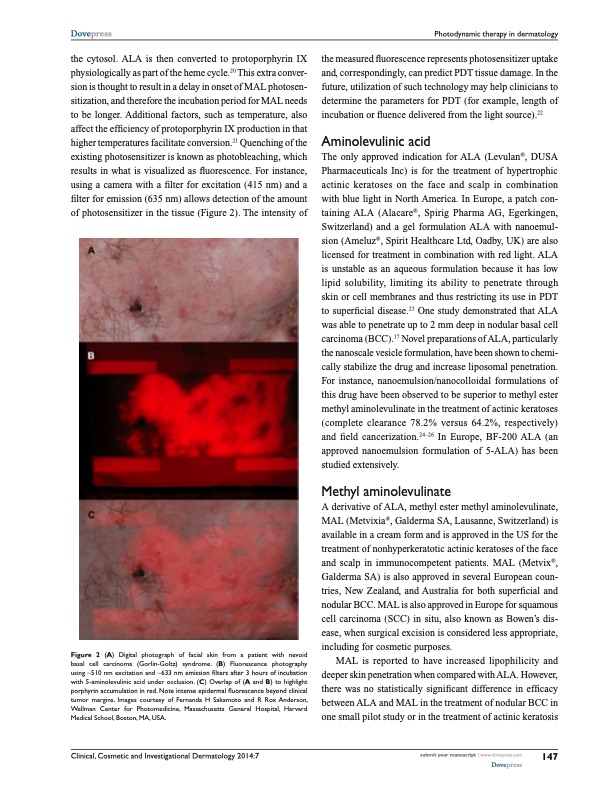
PDF Publication Title:
Text from PDF Page: 004
Dovepress Photodynamic therapy in dermatology the cytosol. ALA is then converted to protoporphyrin IX physiologically as part of the heme cycle.20 This extra conver- sion is thought to result in a delay in onset of MAL photosen- sitization, and therefore the incubation period for MAL needs to be longer. Additional factors, such as temperature, also affect the efficiency of protoporphyrin IX production in that higher temperatures facilitate conversion.21 Quenching of the existing photosensitizer is known as photobleaching, which results in what is visualized as fluorescence. For instance, using a camera with a filter for excitation (415 nm) and a filter for emission (635 nm) allows detection of the amount of photosensitizer in the tissue (Figure 2). The intensity of Figure 2 (A) Digital photograph of facial skin from a patient with nevoid basal cell carcinoma (Gorlin-Goltz) syndrome. (B) Fluorescence photography using ∼510 nm excitation and ∼633 nm emission filters after 3 hours of incubation with 5-aminolevulinic acid under occlusion. (C) Overlap of (A and B) to highlight porphyrin accumulation in red. Note intense epidermal fluorescence beyond clinical tumor margins. Images courtesy of Fernanda H Sakamoto and R Rox Anderson, wellman Center for Photomedicine, Massachusetts General Hospital, Harvard Medical School, Boston, MA, USA. Clinical, Cosmetic and Investigational Dermatology 2014:7 the measured fluorescence represents photosensitizer uptake and, correspondingly, can predict PDT tissue damage. In the future, utilization of such technology may help clinicians to determine the parameters for PDT (for example, length of incubation or fluence delivered from the light source).22 Aminolevulinic acid The only approved indication for ALA (Levulan®, DUSA Pharmaceuticals Inc) is for the treatment of hypertrophic actinic keratoses on the face and scalp in combination with blue light in North America. In Europe, a patch con- taining ALA (Alacare®, Spirig Pharma AG, Egerkingen, Switzerland) and a gel formulation ALA with nanoemul- sion (Ameluz®, Spirit Healthcare Ltd, Oadby, UK) are also licensed for treatment in combination with red light. ALA is unstable as an aqueous formulation because it has low lipid solubility, limiting its ability to penetrate through skin or cell membranes and thus restricting its use in PDT to superficial disease.23 One study demonstrated that ALA was able to penetrate up to 2 mm deep in nodular basal cell carcinoma (BCC).17 Novel preparations of ALA, particularly the nanoscale vesicle formulation, have been shown to chemi- cally stabilize the drug and increase liposomal penetration. For instance, nanoemulsion/nanocolloidal formulations of this drug have been observed to be superior to methyl ester methyl aminolevulinate in the treatment of actinic keratoses (complete clearance 78.2% versus 64.2%, respectively) and field cancerization.24–26 In Europe, BF-200 ALA (an approved nanoemulsion formulation of 5-ALA) has been studied extensively. Methyl aminolevulinate A derivative of ALA, methyl ester methyl aminolevulinate, MAL (Metvixia®, Galderma SA, Lausanne, Switzerland) is available in a cream form and is approved in the US for the treatment of nonhyperkeratotic actinic keratoses of the face and scalp in immunocompetent patients. MAL (Metvix®, Galderma SA) is also approved in several European coun- tries, New Zealand, and Australia for both superficial and nodular BCC. MAL is also approved in Europe for squamous cell carcinoma (SCC) in situ, also known as Bowen’s dis- ease, when surgical excision is considered less appropriate, including for cosmetic purposes. MAL is reported to have increased lipophilicity and deeper skin penetration when compared with ALA. However, there was no statistically significant difference in efficacy between ALA and MAL in the treatment of nodular BCC in one small pilot study or in the treatment of actinic keratosis submit your manuscript | www.dovepress.com Dovepress 147PDF Image | applications of photodynamic therapy dermatology

PDF Search Title:
applications of photodynamic therapy dermatologyOriginal File Name Searched:
photodynamic-therapy-dermatology.pdfDIY PDF Search: Google It | Yahoo | Bing
Cruise Ship Reviews | Luxury Resort | Jet | Yacht | and Travel Tech More Info
Cruising Review Topics and Articles More Info
Software based on Filemaker for the travel industry More Info
The Burgenstock Resort: Reviews on CruisingReview website... More Info
Resort Reviews: World Class resorts... More Info
The Riffelalp Resort: Reviews on CruisingReview website... More Info
| CONTACT TEL: 608-238-6001 Email: greg@cruisingreview.com | RSS | AMP |